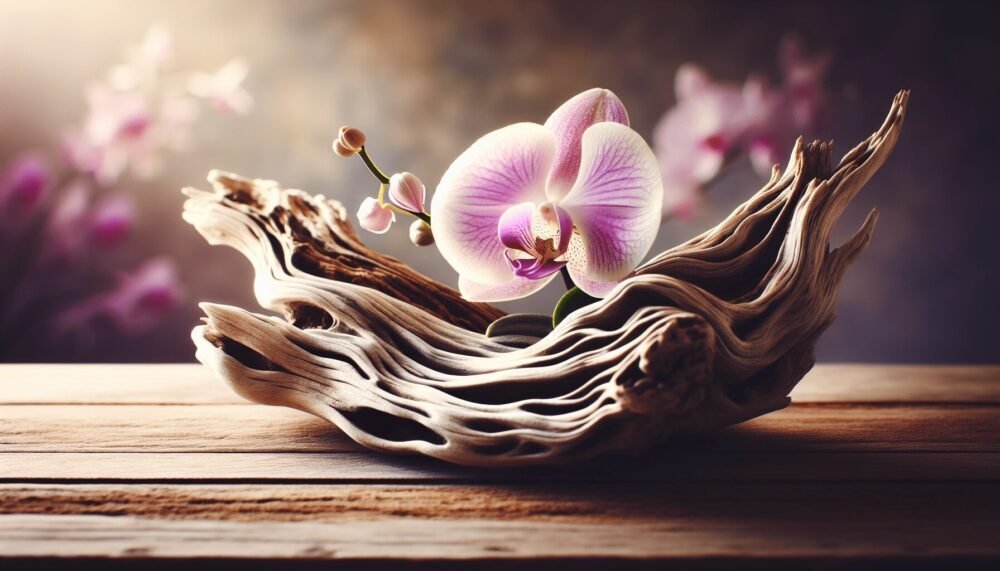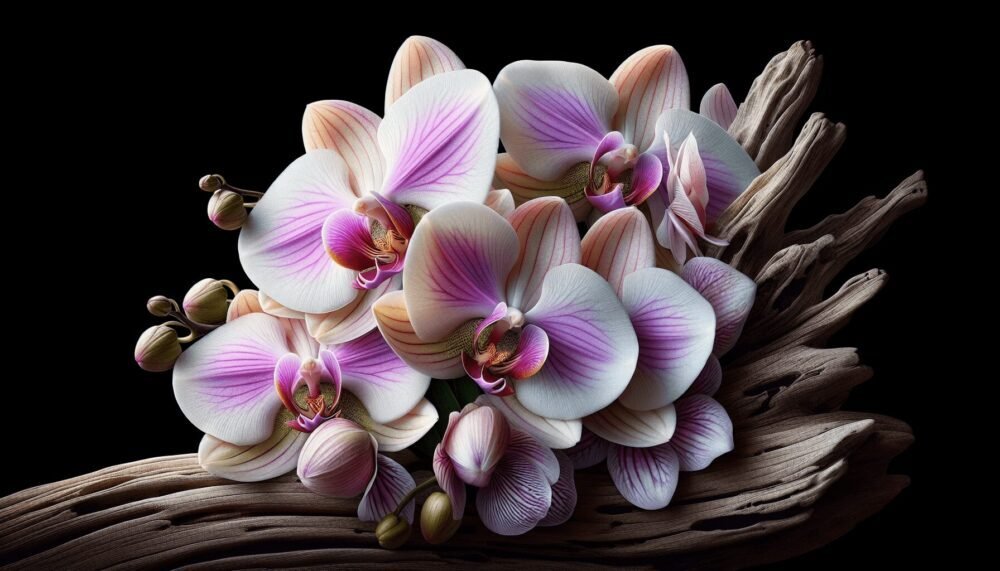Have you ever heard of the Driftwood Orchid? This unique and intriguing plant is a true marvel of nature, melding the beauty of orchids with the raw elegance of driftwood. Whether you’re a seasoned gardener or someone just looking to spruce up your living space, the Driftwood Orchid can offer something special.
What Is a Driftwood Orchid?
A Driftwood Orchid is an interesting combination of natural elements: the stunning blooms of an orchid juxtaposed against the rustic, weathered appearance of driftwood. This unique pairing captures the imagination and adds an artistic element to any environment.
The Appeal of the Combination
Orchids are renowned for their intricate, exotic flowers that captivate anyone who looks at them. Meanwhile, driftwood offers an organic, rugged charm developed by years of being shaped by wind and water. When these two elements come together, they create an object of beauty and intrigue.
Origins of the Idea
The concept of combining orchids with driftwood isn’t new; it actually comes from the natural growing conditions of some wild orchids. These orchids often cling to trees and rocks in their native habitats, drawing nutrients and water from the air and rain. By mounting orchids on driftwood, you mimic these natural conditions, creating a miniature version of their ecosystem.
Selecting the Right Orchid
Not all orchids are suitable for mounting on driftwood. Choosing the right species can drastically affect the health and appearance of your driftwood orchid.
| Type of Orchid | Suitable for Driftwood? | Characteristics |
|---|---|---|
| Phalaenopsis (Moth Orchid) | Yes | Long-lasting flowers, humidity-tolerant, common and easy to find. |
| Dendrobium | Yes | Strong roots, can withstand a bit more arid conditions. |
| Cattleya | Sometimes | Beautiful blooms but may need more care and specific conditions. |
| Vanda | Yes | Aerial roots ideal for mounting, require bright light and high humidity. |
| Lycaste | No | Generally prefer potted settings, more challenging to adapt for mounting. |
Selecting the right orchid largely depends on your environment and how much care you’re willing to invest. Some orchids may need more humidity and light, while others are more resilient and easier to maintain.

Choosing the Perfect Driftwood
Choosing the right piece of driftwood is equally important. Unlike orchids, driftwood doesn’t need any care, but it does need to provide a stable, aesthetically pleasing base for the orchid.
Types of Driftwood
Not all driftwood is created equal. Here are some types that work particularly well:
| Type of Driftwood | Characteristics |
|---|---|
| Bogwood | Dark, dense wood often found in freshwater; ideal for dramatic, contrasting appearances. |
| Manzanita | Known for its twisted, intricate branches; very strong and durable. |
| Grapewood | Lighter, more fragile; suitable for smaller orchids or less dominant displays. |
| Cork Bark | Very lightweight and easy to work with, but may not be as aesthetically pleasing for everyone. |
Preparing the Driftwood
Once you’ve selected your driftwood, you might need to prepare it. Cleaning with a brush and water is usually sufficient, but some prefer to bake or boil the wood to sterilize it.
Mounting Your Orchid on Driftwood
Now comes the fun part: mounting your orchid onto the driftwood. This process isn’t as complex as it sounds, but it does require a bit of precision and patience.
Necessary Materials
Before you start, gather the following materials:
- Your chosen orchid
- Your prepared driftwood
- Fishing line or floral wire
- Moss (sphagnum or Spanish)
- Scissors
- Spray bottle with water
Step-by-Step Guide to Mounting
- Select the Site: Identify natural pockets or crevices in the driftwood where the orchid can be securely seated.
- Moisten the Orchid Roots: Use a spray bottle to dampen the orchid roots. This makes them more flexible and less prone to breaking.
- Attach Moss: Place a small amount of moistened moss around the orchid roots. This helps retain moisture.
- Position the Orchid: Place the orchid on the driftwood. Make sure it’s stable and positioned to your liking.
- Secure with Fishing Line: Use fishing line or floral wire to attach the orchid to the driftwood. Wrap securely but not too tightly, as the orchid needs room to grow.
- Water Thoroughly: Spray the entire establishment with water to help the roots settle.
Remember, the look you’re aiming for is natural and organic, so don’t worry about being too precise—the roots and flowers will grow and evolve over time.

Caring for Your Driftwood Orchid
Maintaining a driftwood orchid can be different from caring for a potted one. Here are essential aspects to keep in mind.
Light Requirements
Most orchids prefer indirect light. Direct sunlight can scorch the leaves, while insufficient light will prevent blooming. Place your driftwood orchid where it can get bright, filtered light for the best results.
Watering
Watering is crucial but tricky. Over-watering can cause root rot, while under-watering will dry out the roots. Aim to mist the roots and moss regularly, 2-3 times a week, allowing the moss to dry out slightly between waterings.
Humidity
Orchids thrive in humid environments. If you live in a dry area, placing a humidity tray nearby or using a humidifier can create a more comfortable growing environment.
Fertilizing
While orchids mounted on driftwood won’t need as much fertilizer as potted ones, they still need nutrients. A balanced, water-soluble orchid fertilizer applied once every month works well.
Pruning and Maintenance
Prune dead or yellowing leaves to promote new growth. Removing spent flowers also encourages energy to be redirected towards new blooms.
Benefits of Driftwood Orchids
You might wonder why you should go through all this if a potted orchid seems easier. The advantages of a driftwood orchid go beyond mere aesthetics.
Natural Aesthetic
One of the most compelling reasons to opt for a driftwood orchid is its appearance. This natural, organic combination beautifies any space and provides a conversation piece.
Versatility
Driftwood orchids can be placed almost anywhere—on a coffee table as a centerpiece, mounted on a wall, or even hanging from the ceiling. Their adaptability makes them a perfect addition to various interior styles.
Connection to Nature
Tending to a driftwood orchid can also bring a sense of connection to nature, mimicking the plant’s natural growing conditions and understanding its needs.
Potential Challenges
Although driftwood orchids are rewarding, they come with challenges. Being prepared for these can help you manage them better.
Moisture Control
Balancing moisture levels can be tricky. Over-watering can lead to root rot, while under-watering can dry out the orchid. Regular monitoring is essential.
Light Conditions
Finding the right light balance is crucial. Too much light can burn the orchid, while too little hampers growth and blooming. Adjusting positioning as needed can help.
Pest and Disease Control
Like all plants, driftwood orchids are susceptible to pests and diseases. Regularly inspect for common pests like aphids and mites. Treat at the first sign of infestation using appropriate methods, such as neem oil or insecticidal soap.
Driftwood Orchid in Home Decor
Integrating a driftwood orchid into your home decor is a wonderful way to bring nature indoors. Here’s how you can do it:
Living Room
A driftwood orchid can serve as a striking centerpiece on your coffee table or a focal point on a shelf. Place it where it can catch both natural light and the eyes of your guests.
Office Space
Workspaces benefit from a touch of greenery. A driftwood orchid can be placed on a desk or near a window, offering a calming and aesthetically pleasing environment.
Bathroom
Bathrooms, especially those with good humidity, can be ideal locations for driftwood orchids. Place them near a window where they can get some filtered light.
Outdoor Spaces
If you have a humid, shaded outdoor area, driftwood orchids can thrive there as well. Just be sure to bring them indoors when the weather becomes too extreme.
Sustainability and Ethical Considerations
When creating your driftwood orchid, it’s essential to think about sustainability. Ensure that your driftwood is sourced ethically, ideally collected from naturally fallen wood or reclaimed sources. Avoid stripping living trees or disturbing natural habitats.
Frequently Asked Questions
How often should I water my driftwood orchid?
Generally, misting the roots and moss 2-3 times a week is sufficient. The key is to allow some drying out between waterings to prevent root rot.
Can I use any type of orchid for driftwood mounting?
Not all orchids are suitable. Varieties like Phalaenopsis, Dendrobium, and Vanda are good choices, whereas Lycaste tends to do better in pots.
Do driftwood orchids need special fertilizer?
Yes, a balanced, water-soluble orchid fertilizer works best. Apply once a month to ensure the plant receives the necessary nutrients.
How do I deal with pests?
Regularly inspect your orchid. If you notice pests, treat them immediately with neem oil or an appropriate insecticidal soap.
How long do the flowers last?
Orchid blooms can last from a few weeks to several months, depending on the variety and care.
Conclusion
Creating and maintaining a driftwood orchid is a deeply rewarding experience. The blend of the rugged driftwood with the elegant orchid creates a natural masterpiece that can enhance any living space. By understanding the needs of both the driftwood and the orchid, you can enjoy a beautiful, thriving plant that brings a touch of nature and a unique aesthetic into your home.